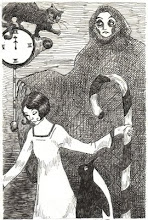
In one of my favorite Calvin and Hobbes comics, Calvin's father tells him how the world was actually in black and white until the thirties, when grainy color started to emerge. What makes it so funny is that it almost feels as if it was true - that the world just suddenly burst into color after centuries of everything being in grayscale. Just trying to picture what the world must have really, actually looked like sixty, seventy, a hundred years ago is incredibly difficult. We have no frame of visual reference for seeing most of it in color.

Which is exactly what makes this posting from the Denver Post photo blog so compelling. They've posted seventy color photos that were taken between 1939 and 1943 by photographers working for the Farm Security Administration, and they are nothing short of a revelation. Many of us are familiar with the iconic black and white images of rural Americans during the Depression taken by greats such as Walker Evans, Dorothea Lange, Gordon Parks and many others. They are strong and sad and tough and beautiful. And they are in black and white. So they don't look quite real.

Black and white photographs can be beautiful. They can be stark, glamorous or surreal. But the lack of color can also serve as a distancing device. The people in these photos look slightly otherworldly, apart. Our world is in full technicolor and surround sound, theirs is still, silent and gray. The color Farm Security Administration photos are a completely different story. For a long time color photography was denigrated. It wasn't thought of as art. Anyone after seeing these images with their blazing immediacy would know right away that that notion is total nonsense.

My friend who posted this on facebook got it exactly right: they're like a time machine. You feel as if you could step right into them and walk around the wide small town streets and talk to all the people. And then you look again, and wonder who all these people are, what their names are, what they're thinking, what happened to them after. And then you wonder if things ever got any easier for them and then you realize that most of them are probably dead.

A continent and an ocean away, other Americans were also revolutionizing photography. First, in the early 30s, Man Ray and Lee Miller experimented with surreal images and new techniques. Influenced by Art Deco and the Bauhaus, art and fashion photographers (most of whom worked for Vogue) made beautiful and intentionally artificial black and white photos. They were glamorous and completely otherworldly, with carefully composed, elegant images. The kinds of photos I've posted here bridge the gap between journalism and art, much the way Truman Capote's In Cold Blood did for the written word 30 years later. They make me wish Brassaï would have worked occasionally in color so that I could see Paris. These photos lack the stark perfection of those two carefully posed swimmers at the end of that diving board, but the swimmers are dream figures, while a very different boy and girl (above) living at the same time a world away are not.

The picture above was taken in a place called Pie Town, New Mexico. It still exists, and though the homesteaders don't live in dug outs anymore, they are still famous for their pies. Photography is a remarkable thing. It makes art out of capturing in light and paper the briefest of moments. They are time machines and a miracle.
(Photos: Library of Congress, Prints & Photographs Division, FSA-OWI Collection. They are not subject to copyright within the United States.)

















2 comments:
The 30s in color! Kid stuff! Try freakin' pre-Revolutionary Russia in color!
http://www.loc.gov/exhibits/empire/
Almost as fascinating as the photos---which are pretty goddamn fascinating---is the history of the process. Prokudin-Gorskii had developed a system in which each photo came out in three versions, essentially corresponding to what you see in the RGB channels in Photoshop. Those images were then projected through differently colored lenses aimed at a single point. So he invented the process used by Photoshop, computer monitors, video projectors, and he did it at the turn of the last century. But because it didn't produce an object you could hold, it was considered a commercial failure, abandoned and forgotten.
Wow. Wow. Wow.
Post a Comment